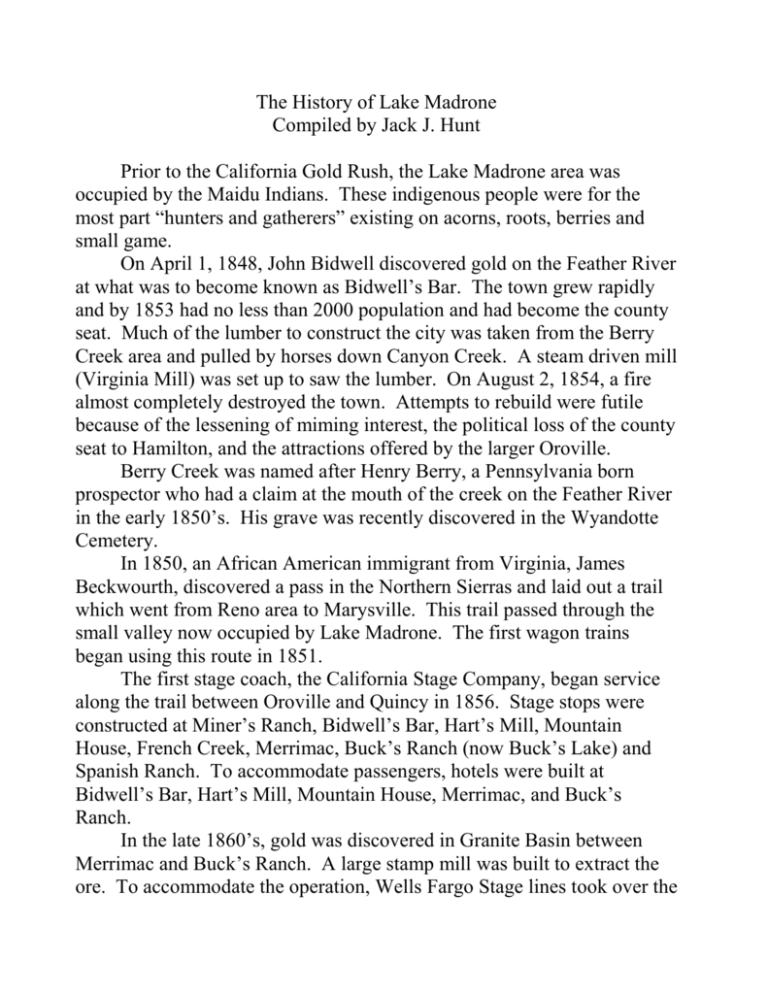The History of Lake Madrone
advertisement

The History of Lake Madrone Compiled by Jack J. Hunt Prior to the California Gold Rush, the Lake Madrone area was occupied by the Maidu Indians. These indigenous people were for the most part “hunters and gatherers” existing on acorns, roots, berries and small game. On April 1, 1848, John Bidwell discovered gold on the Feather River at what was to become known as Bidwell’s Bar. The town grew rapidly and by 1853 had no less than 2000 population and had become the county seat. Much of the lumber to construct the city was taken from the Berry Creek area and pulled by horses down Canyon Creek. A steam driven mill (Virginia Mill) was set up to saw the lumber. On August 2, 1854, a fire almost completely destroyed the town. Attempts to rebuild were futile because of the lessening of miming interest, the political loss of the county seat to Hamilton, and the attractions offered by the larger Oroville. Berry Creek was named after Henry Berry, a Pennsylvania born prospector who had a claim at the mouth of the creek on the Feather River in the early 1850’s. His grave was recently discovered in the Wyandotte Cemetery. In 1850, an African American immigrant from Virginia, James Beckwourth, discovered a pass in the Northern Sierras and laid out a trail which went from Reno area to Marysville. This trail passed through the small valley now occupied by Lake Madrone. The first wagon trains began using this route in 1851. The first stage coach, the California Stage Company, began service along the trail between Oroville and Quincy in 1856. Stage stops were constructed at Miner’s Ranch, Bidwell’s Bar, Hart’s Mill, Mountain House, French Creek, Merrimac, Buck’s Ranch (now Buck’s Lake) and Spanish Ranch. To accommodate passengers, hotels were built at Bidwell’s Bar, Hart’s Mill, Mountain House, Merrimac, and Buck’s Ranch. In the late 1860’s, gold was discovered in Granite Basin between Merrimac and Buck’s Ranch. A large stamp mill was built to extract the ore. To accommodate the operation, Wells Fargo Stage lines took over the route. The first post office was established at Berry Creek on May 10, 1875. On July 25, 1878, the wells Fargo Stage was held up very close to the now Lake Madrone by the notorious Black Bart. He got $379 in coin, a gold watch ($25) and a diamond ring ($200.) Upon fleeing, Black Bart stole some boots from the front porch of a local farmer leaving his old ones with a poem: Here I lay me down to sleep To wait the coming morrow, Perhaps success, perhaps defeat, And ever lasting sorrow. Let come what will I’ll try it on, My condition can’t be worse, And if there’s money in that box, “Tis munny in my purse” Black Bart, The P08 Even though he was known as the poet bandit, in fact he had left only two poems in all his robberies. The farmer’s home is now where the small horse ranch is a mile south of Lake Madrone. Rumor has it that following the hold-up, Black Bart hid from the posse in the basement of the Mountain House Hotel. A gold deposit was discovered in the early 1900’s ¼ mile south of Lake Madrone (now Aird Way.) The Berry Creek Mine lasted until 1920. Its yield was over $2,000,000 making it one of the richest single mines in Butte County. The Berry Creek Hotel was built (in the draw above the now Lake Madrone Dam spillway) to house the miners. The now Pioneer Cemetery was established on the hill over looking the hotel. When the mine was depleted, now inundated with water, the hotel went into disrepair and was destroyed by fire in the mid 1920’s. In the 1920’s, a small mill was built at now Lake Madrone and the area was logged. A small earthen dam (the Apple Tree Dam) to be used as a mill pond and roadway was built just up stream from the present dam. The earthen dam was washed out in 1929 hastening the need for a new roadway. The remnants of the old dam were removed during the lake clean-out in 1984. Also during the 1920’s, the Swayne Lumber Company established a right of way for their narrow-gauge railroad through the area to carry logs from the Merrimac forests to Oroville. This railroad grade is presently Panorama Drive. In 1925, George C. Mansfield, editor of the Oroville Register, was appointed by Governor W.D. Stevens to the State Highway Commission. In this position, he became a long-term promoter for a state highway connecting Oroville with Quincy and Reno. In 1928, Mansfield convinced the state to build a dam across Berry Creek for the highway and thus Lake Madrone was formed. The dam was unusual for the area in that it is a siphon dam. Within the dam are floats that depending on the water level rise and drop allow water discharge from various levels of outlets. A coffer dam was built directly below the dam to divert water into the Berry Creek Water Company ditch to supply irrigation water to the residents of the Canyon Creek area. On December 2, 1929, George C. Mansfield, along with fellow Canadian native, Duncan McCallum, grandfather of present lake resident William Floyd Jr., established the Feather River Forest Homes Unit 1 subdivision on the south side of the lake. Shortly thereafter they established the Lakeview addition on the south-east side and then the Cascade addition on the north-east side of the lake. The first lot was sold to Will and Vida Bond of Gridley, parents of present lake resident Edith Eagan. This cabin is presently the home of Robert Rogers at 10 Cedar Path. A water system, consisting of a small stream filling a redwood tank that fed into cast iron pipes, was built on Bootlegger Creek north-east of the lake. Shortly after the dam and highway were built, the Lake Madrone Trading Post was constructed. It consisted of a store, bar and Shell gas station. The gad pump consisted of a pump with a glass dome on top. A customer would hand pump an amount of gas up into the dome until the proper amount was shown and then gravity fed into the car. Four small cabins were available for rental the hill above “the Post” along with a row boat rental. With the decline of major logging in the 1960’s, “the Post” contributed its success more to the hospitality of the owners than being “the only bar in town.” The name was changed to Lake Madrone Inn in 1975, although it is still referred to as “the Post” by the Lake Madrone old-timers. Several owners occupied it from the 1960’s to the 80’s. It was at one time a cook-it-yourself steak house and later a full service restaurant. The Lake Madrone Inn Closed for the last time in 1988. During the later part of the 1950’s, the cabin just above “the Post” (7 Lakeside Way served as the Berry Creek Library, until it was replaced by the Butte County Bookmobile. In the early 1960’s, the northern undeveloped properties of Lake Madrone was acquired by Warren Pittman, an Oroville real estate developer. Pittman formed Lake Madrone Properties and the Spring Valley Addition was established. A water system was built which is currently the main source of water for the Lake Madrone Water District (now the Star System). The Bootlegger Water System was abandoned and new water transmission lines were installed. Later, Pittman developed Spring Valley Addition No. 2 along the west side of Old Mill Road and north of the Galen Ridge Road. Madrone Lake Properties was acquired by Paul Gardiner and later by Warren Byers in 1974. The Oroville-Quincy Road was improved with the straightening of the Hart’s Mill grade in 1964. With the building of the Oroville Reservoir, the highway was completely re-routed in 1966 and became State Highway 162 from Oroville to Foreman Creek. In 1983, the L.M.W.D drilled a well and installed a 14,000 gallon tank on Panorama Drive which was used as a back-up system. Also, in the early 1900’s major improvements were made on the pumping and storage capacities of the Star System. Prior to 1975 two property owner groups existed at Lake Madrone, the Lake Madrone Property Owners Association and the Galen Creek Association. In the November 1975 election, the Lake Madrone Water District was formed with Sherman Hinaman becoming its first president. The L.M.W.D. employed Fred Danz (Deputy Dog) as its first lake caretaker and he remained until his death in August 1983. He was replaced by Bodil Kruger, who presently serves as caretaker. From 1975 until 1987, the newly formed water district went through a major litigation period: lake privilege for property owners, State Bureau flood spillway, power boat privileges and water rights to the Star Water System. Fortunately, the L.M.W.D. prevailed. Due to liability reasons, several recreation facilities were removed: the diving board on the south side of the lake, three boat houses, two wooden rafts and numerous docks around the lake. The Lake Madrone 4th of July celebrations began in 1961 by resident Gloria Vaughan. The festivities consisted of boat regatta, kiddie parade and potluck dinner. The annual potlucks only continued until the mid1980’s when the later Beverly Beers organized the annual event to include a flag-raising, canoe races, kiddie games and a horse shoe tournament. The late Sam Bass, resident and Beverly Beer’s brother, organized the first Lake Madrone cook-out crew and resident jack Hunt provided the first borrowed sound system (generator-operated, no power on beach) for the annual celebration dance. This tradition has continued and now is into its 43rd year.








